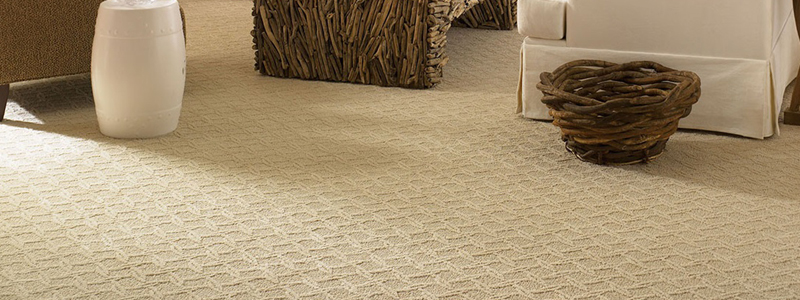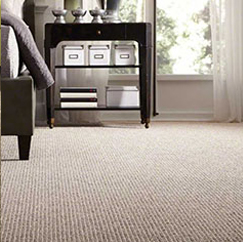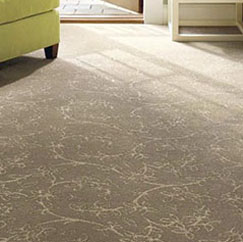 Carpeting adds comfort and warmth to any room in the house. There are many options to choose from in selecting carpet flooring. Cost and color are important factors as well as understanding construction and style attributes.
Carpeting adds comfort and warmth to any room in the house. There are many options to choose from in selecting carpet flooring. Cost and color are important factors as well as understanding construction and style attributes.
Get inspired! Use our room visualizer (icon on bottom right) to see today’s innovative flooring products in your home.


Loop Pile Carpet has dense, looped strands of carpet fibers. Level loop (Berber) is a very durable low profile style that is ideal for high-traffic areas. Multi-level loops have varying heights to give carpet a patterned texture.
Cut Pile Carpet has had the looped strands cut creating two separate carpet fiber tufts. It tends to be softer than loop pile and is offered in several types:
- Plush/Velvet has an even, smooth texture with a formal appearance – can show vacuum marks.
- Saxony has a smooth finish with longer twisted fibers for more body – footprints can linger.
- Textured has fibers of uneven lengths with more twist to create a less formal look and rougher surface texture.
- Frieze and Shag carpet has long, twisted fibers for a comfortable, casual look and feel.
Cut and Loop Pile Carpet has both cut pile and loop pile fibers, combining the best qualities of both, and creating a wide range of patterns.
Create simple, modern or upscale looks with a loop, pattern or twist style carpet.
Come visit our Lakewood Ranch or Sarasota showroom to find an option to fit your lifestyle or call today to schedule your free flooring estimate and shop at home!



Call Today for Your Free Estimate!
Frequently Asked Questions (FAQs)
- Do you have a family that spends a lot of time at home?
- What are the high traffic areas around your home?
- What is the likelihood of staining (from mud, food, etc)?
- Do you have pets?
- Do you want to create a certain style?
- What is your budget?
| Attribute | Wool | Nylon | Olefin | Polyester |
| Resiliency | Good to Excellent | Excellent | Excellent | Good to Excellent |
| Abrasion Resistance (the more tightly packed the yarns, the more resistant to wear) | Good to Excellent | Excellent | Excellent | Good to Excellent |
| Soil & Stain Resistance (cleanability) | Good to Excellent | Good to Excellent | Good (oily stains should be treated promptly) | Good to Excellent (oily stains should be treated promptly) |
| Resistance to Sunlight | Poor (if protected from ultraviolet rays, degradation does not occur as rapidly) | Good (special dyes may be used to inhibit sun damage) | Loses strength and deteriorates unless modified | Good (may weaken with prolonged exposure) |
| Static | Builds up in low humidity unless modified | Builds up in low humidity unless modified | Builds up in low humidity, but at lower levels than nylon or polyester | Builds up in low humidity unless modified |
| Touch/Feel | Warm, soft | Varies from warm and soft to cold and coarse | Waxy, soft | Varies (can be soft and silky) |
Maintenance
- Vacuum your carpet regularly to prevent soil from embedding itself in the pile. Depending on the type of carpet you have, you’ll want to use a vacuum with a rotating brush, a beater bar, or suction only.
- Keeping traffic and other use factors in mind, consider professional cleaning every 12 to18 months. Use scissors to clip sprouts and snags. Don’t pull on them—you might damage the carpet.
- If your carpet is burned, simply remove the tops of the dark, burnt fibers with curved fingernail scissors. If the burn is extensive, you may need to patch or replace it.
- Remove heavy furniture dents by stroking the dented area with the edge of a coin. You can also use a hair dryer or a steam iron, but be very careful not to touch the carpet with the iron.
- For extensive water damage, consult professional cleaners to dry your carpet from the front and back, as well as the carpet padding.
- Always treat the affected area immediately. The longer the spill sits, the harder it’ll be to remove the stain.
- For a food spill, gently remove as much solid material as you can with a spoon or dull knife. Add water and blot, using detergent sparingly if needed. Then, using the highest suction function, vacuum back and forth, adding more water to the stain as you go until completely clean.
- If you need a spot removal solvent, use a product approved by The Carpet and Rug Institute of America. Apply several drops to a clean, white cloth and blot the carpet in an inconspicuous area. If you notice a change in the carpet color, consult a professional carpet cleaner.
- If stains remain after cleaning, moisten tufts in the stained area with 3% hydrogen peroxide and let stand for one hour. Blot and repeat until completely clean.

 NO TARIFF INVENTORY SALE!
NO TARIFF INVENTORY SALE!